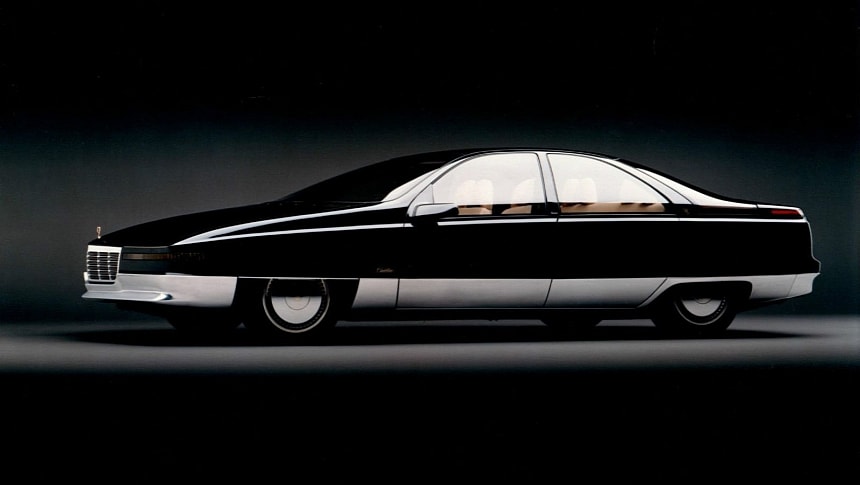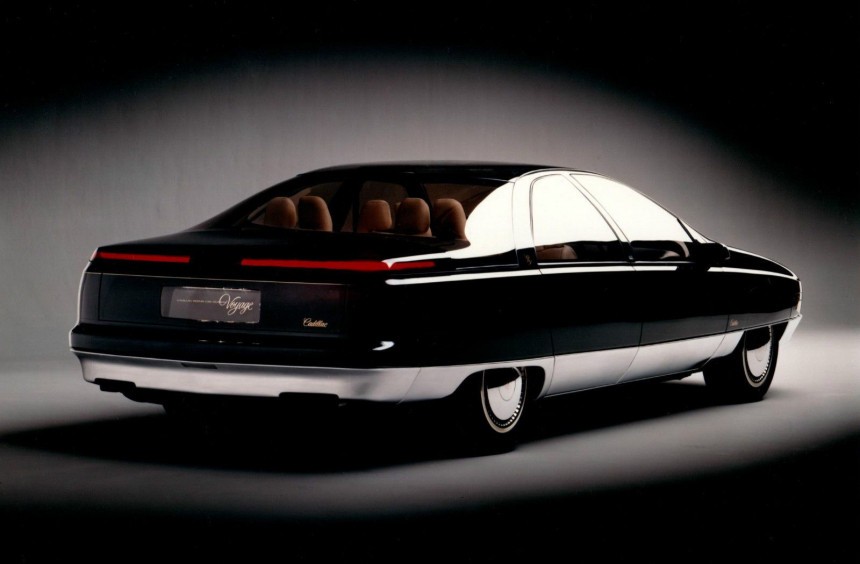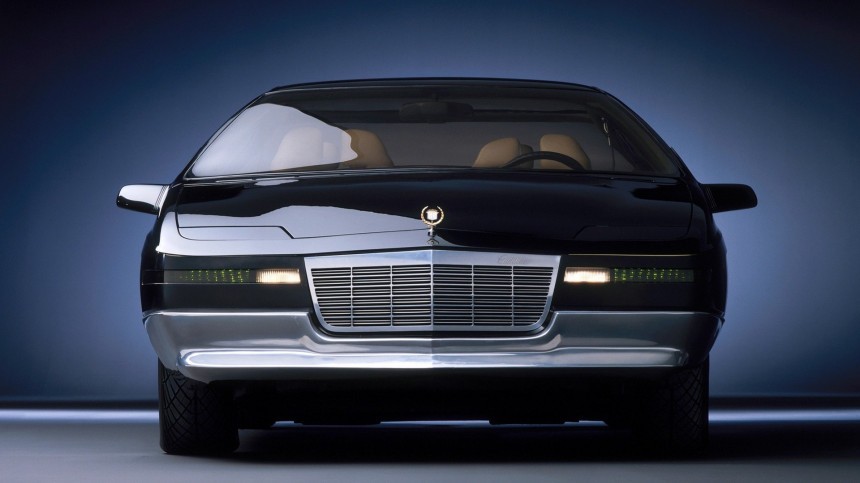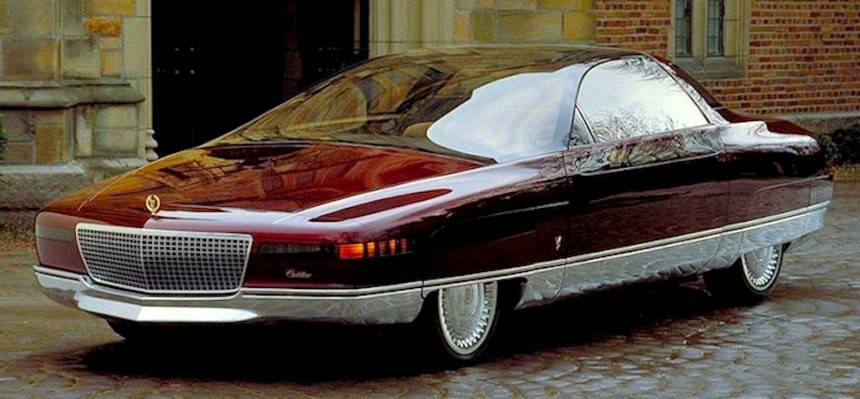It was 1988, and Cadillac rolled out the Voyage concept car. It was a rolling laboratory. It was packed with technology, all wrapped in a sleek silhouette that seemed out of this world at the time. Almost four decades later, nostalgics still believe that Cadillac should have built a production version of the Voyage.
General Motors unveiled the Cadillac Voyage concept car at the Teamwork and Technology Show at the Waldorf Astoria Hotel in New York, in January 1988. They called it Voyage, with a French pronunciation, not the English one, because it was one sophisticated piece of metal.
Many label the Voyage as the car that saved Cadillac from their own mistakes and refrains. They wanted to show everyone what the future would hold. And they used the Voyage rolling laboratory to integrate everything that went through their minds. In fact, the exterior was the brainchild of Advanced Studio design chief Jerry Brochstein.
So, the Voyage was a monster super-long luxury sedan that measured 212.6 inches (5.4 meters), just as Cadillac was trying to downsize. That was the size of a pickup truck, stuffed with futuristic tech and comfort features. Cadillac had a game plan and had to stick to it.
It came with an innovative design, exuding grandeur no matter how you looked at it and sported a drag coefficient of only 0.28, despite the large, upright front end and still boxy proportions. No matter how much they tried, no matter how radical the shift in design was, Cadillac still couldn't leave that kind of obsession behind.
Meanwhile, the windshield wipers were hidden, and Cadillac planted unconventional door locks. Furthermore, the bumperettes were fully integrated into the body of the car, while the angled windshield threw the air up and over the vehicle.
The Cadillac Voyage used a keyless entry system that required a code to unlock. The concept was different from the keyless systems of today, when nobody would have enough patience or time to unlock the doors with a code.
Once opened, the doors cleared the way to a world of luxury and high-tech, stuffed into the cabin, under a complete glass roof. The driver's seat featured a 20-way power adjustment, while both front seats featured heat and massage functions, while the headrests had a shape that had never been seen before.
The built-in phone, integrated into the front armrest was based on voice recognition, while the navigation system was capable of choosing the best route once the destination was set and of displaying it on the screen.
The car could, in fact, switch from all-wheel drive to rear-wheel drive and vice versa, depending on the road conditions. For instance, it went from RWD to AWD if the built-in sensors detected the rear end slipping.
The official top speed figure was actually electronically limited and it was only an estimation, as GM had never tested it. A four-speed automatic gearbox put the power down.
Cadillac installed a huge one-piece tinted glass that stretched from the windshield all the way to the rear of the car, above the taillights, for improved visibility. Furthermore, there was also a rearview camera that sent footage to a screen onboard the car when screens weren't really common.
The model featured an LED strip as taillights, similar to what many cars come with. But that wasn't a thing until the 2020s.
It was a time when such systems were nowhere near production. It was an era when navigation and unlock codes were out of this world. However, GM rolled out the Cadillac Voyage to wow the crowds, to show them there is a new world out there, one in which cars have automatic doors, GPS navigation systems, and reversing cameras.
A year later, overwhelmed by the attention that the concept car attracted, Cadillac unveiled the Solitaire concept, which was basically the two-door version of the Voyage and featured a different engine. It came with a 6.6-liter V12, co-developed with Lotus. The power unit generated 430 horsepower.
This one did not go into production either. Cadillac used both as a preview to technologies that were to come in the following years. But in 1988, they were lightyears away from even making it to the list of optional features on any production car.
Many label the Voyage as the car that saved Cadillac from their own mistakes and refrains. They wanted to show everyone what the future would hold. And they used the Voyage rolling laboratory to integrate everything that went through their minds. In fact, the exterior was the brainchild of Advanced Studio design chief Jerry Brochstein.
So, the Voyage was a monster super-long luxury sedan that measured 212.6 inches (5.4 meters), just as Cadillac was trying to downsize. That was the size of a pickup truck, stuffed with futuristic tech and comfort features. Cadillac had a game plan and had to stick to it.
It came with an innovative design, exuding grandeur no matter how you looked at it and sported a drag coefficient of only 0.28, despite the large, upright front end and still boxy proportions. No matter how much they tried, no matter how radical the shift in design was, Cadillac still couldn't leave that kind of obsession behind.
Unconventional solutions in the name of aerodynamics
The design of the Voyage had been tested again and again in the wind tunnel. To help reduce wind resistance, special front skirts were designed to automatically move outward when the car took a sharp corner, making that drag coefficient possible.The Cadillac Voyage used a keyless entry system that required a code to unlock. The concept was different from the keyless systems of today, when nobody would have enough patience or time to unlock the doors with a code.
Once opened, the doors cleared the way to a world of luxury and high-tech, stuffed into the cabin, under a complete glass roof. The driver's seat featured a 20-way power adjustment, while both front seats featured heat and massage functions, while the headrests had a shape that had never been seen before.
The built-in phone, integrated into the front armrest was based on voice recognition, while the navigation system was capable of choosing the best route once the destination was set and of displaying it on the screen.
Cadillac never actually tested the top speed of the Voyage
It was powered by a 4.5-liter V8 engine, which pumped out 275 horsepower in an all-wheel drive setup. The sedan was capable of transporting people in perfect comfort at speeds of up to 200 mph (322 kph). A V12 was part of the plan, but Cadillac was in a hurry and ditched the plan.The official top speed figure was actually electronically limited and it was only an estimation, as GM had never tested it. A four-speed automatic gearbox put the power down.
Cadillac installed a huge one-piece tinted glass that stretched from the windshield all the way to the rear of the car, above the taillights, for improved visibility. Furthermore, there was also a rearview camera that sent footage to a screen onboard the car when screens weren't really common.
The model featured an LED strip as taillights, similar to what many cars come with. But that wasn't a thing until the 2020s.
It was a time when such systems were nowhere near production. It was an era when navigation and unlock codes were out of this world. However, GM rolled out the Cadillac Voyage to wow the crowds, to show them there is a new world out there, one in which cars have automatic doors, GPS navigation systems, and reversing cameras.
Meet the Solitaire
These are features that usually come standard on most cars today. But, hey, that was 1988, and luxury meant something different from what it does in 2024. All these features were unthinkable at the time.This one did not go into production either. Cadillac used both as a preview to technologies that were to come in the following years. But in 1988, they were lightyears away from even making it to the list of optional features on any production car.










